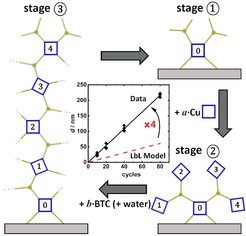NLO and Switchable Materials

Metal-organic frameworks (MOFs), Covalent-organic frameworks (COFs) and similar materials have attracted a great deal of attention in the last few years. Potential areas of application include catalysis, gas adsorption, switchable systems, sensor technologies and many more. In our workgroup we investigate guest molecules inside the pores that can be influenced by external stimuli. The possibility to freely align azobenzene molecules with linearly polarized light could be demonstrated. Furthermore, a strong response of a MOF- and COF- host system with para-nitroaniline to an external alternating field could be shown. Both enable a multitude of possibilities for complex materials and purpose-oriented applications. The topic has been investigated within the DFG priority program COORNETs (SPP 1928).
Publication:
Tillmann Koehler, Ina Strauss, Alexander Mundstock, Jürgen Caro, and Frank Marlow: Reversible Photoalignment of Azobenzene in the SURMOF HKUST-1. J. Phys. Chem. Lett. 12 (2021) 8903–8908.
DOI: 10.1021/acs.jpclett.1c02489
Coverpage:

https://pubs.acs.org/toc/jpclcd/12/36
Synthesis of optically perfect MOF films

The metal-organic framework HKUST-1 grown in a step-wise manner shows growth rates in clear disagreement with the usual layer-by-layer (LbL) model. A nearly exact 4-times higher rate compared to the simple growth model is found and a modified model involving lattice reconstruction is proposed.
Publication:
T. Koehler, J. Schmeink, M. Schleberger, F. Marlow: A hidden chemical assembly mechanism: reconstruction-by-reconstruction cycle growth in HKUST 1 MOF layer synthesis. ChemPhysChem 2025 (e202400968) http://dx.doi.org/10.1002/cphc.202400968


